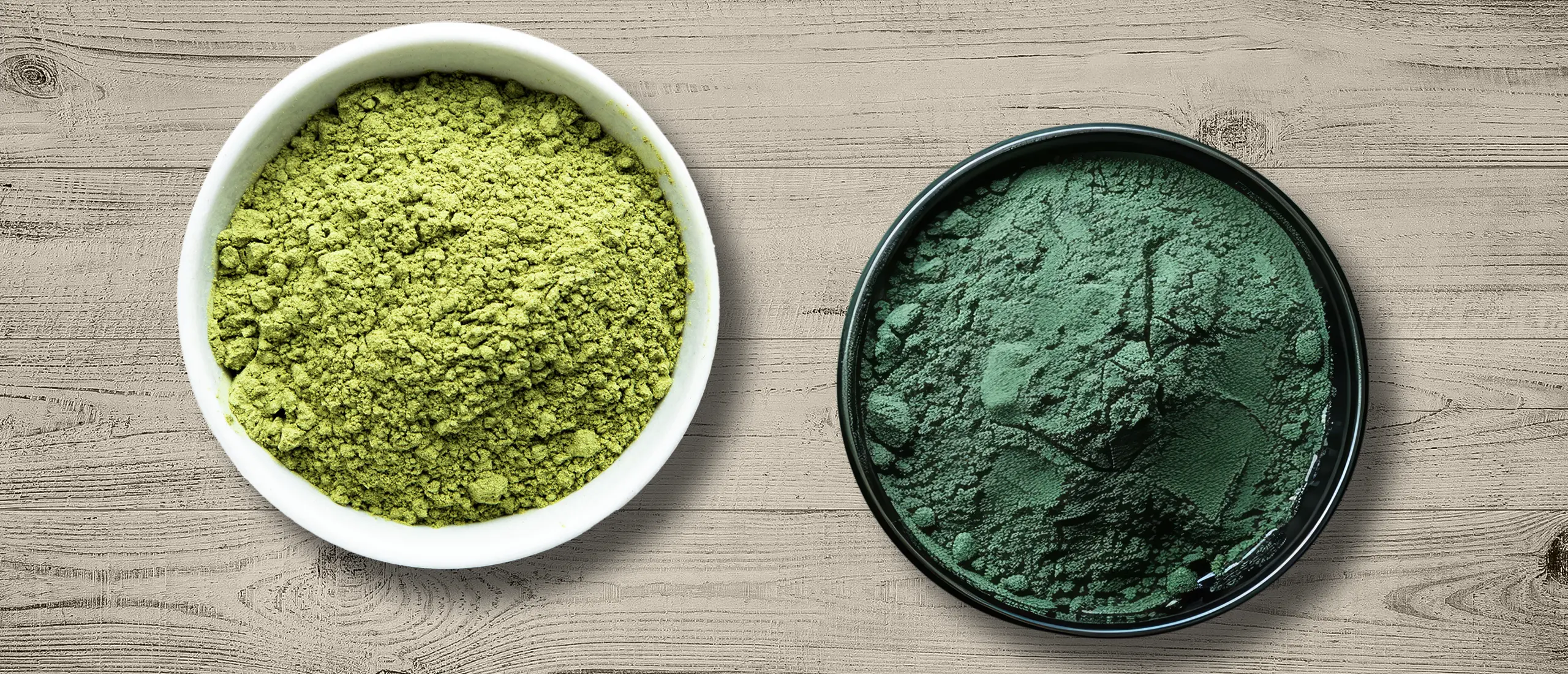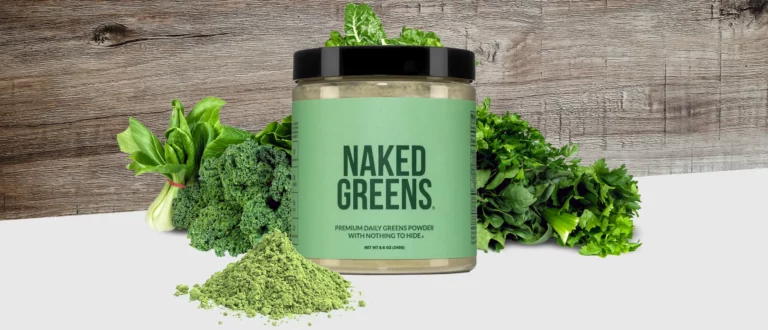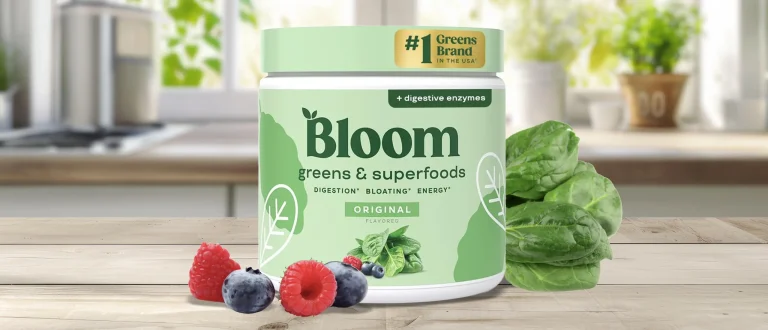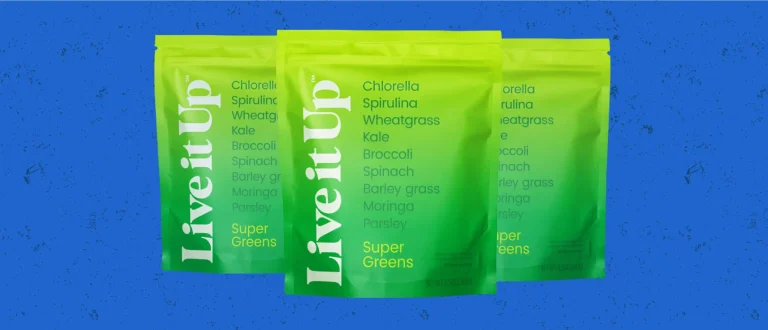In the ocean of superfoods, chlorella and spirulina are some of the biggest fish in the sea. Well, algae technically, but you get the gist. These simple aquatic organisms can enrich your diet with various vitamins and minerals, says registered dietitian Grace Derocha, R.D. Though they’re often mistaken for one another, spirulina and chlorella have their own health benefits.
Whether you’re looking to boost your nutrient intake or enhance your overall wellness, understanding the differences and benefits of chlorella and spirulina will help you make the right choice. We asked Derocha and registered dietitian Kaytee Hadley, R.D., what makes each superfood unique, and how to fit them into your diet.
About the Experts
Grace Derocha, R.D. is a registered dietitian and certified diabetes care and education specialist. She’s based in Detroit, Michigan.
Kaytee Hadley, R.D. is a functional medicine dietitian and founder of Holistic Health and Wellness in Richmond, VA. She has a particular interest in fueling for longevity.
What Is Chlorella?
This microscopic single-celled green algae grows in freshwater, but you’ll find it in tablet, powder, and liquid forms. “It’s high in protein, vitamins, and minerals,” says Derocha. Chlorella is also rich in chlorophyll (which helps to protect the ovaries, testes, and thyroid gland) and loaded with vitamins (such as vitamins D and B12), minerals, and antioxidants (1, 2). It’s been linked with a slew of health benefits, such as bolstering your immune system and minimizing antioxidative stress.
What Is Spirulina?
Spirulina is blue-green algae that thrives best in salt water (though it can grow in either salt or freshwater). As a supplement, you can find it as a powder, flakes, or tablets.
Like chlorella, it’s known for its health benefits, such as supporting your gut health and detoxifying your body from certain heavy metals.
“Spirulina is incredibly nutritious,” says Hadley. “It’s full of protein, vitamins, minerals, carotenoids, and antioxidants, making it a potentially anti-inflammatory food (3).” More specifically, the algae is rich in vitamin E, B complex vitamins, manganese, zinc, and iron (4).
Chlorella vs. Spirulina: What Are the Main Differences?
Chlorella and spirulina are more like cousins than siblings. Based on what’s already in your diet and what you’re looking for in a supplement, one of these may make more sense for you than the other—but you can also enjoy both. (Before starting either supplement, run it by your doctor.)
Here are the key differences between chlorella vs. spirulina, according to Derocha and Hadley.
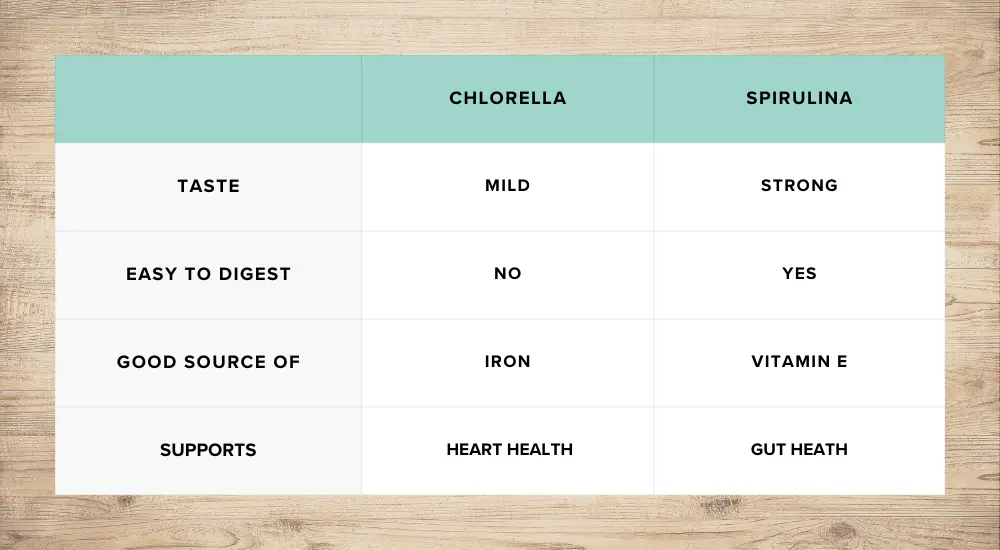
Nutrition
According to the registered dietitians, both supplements pack a nutritional punch with plenty of protein, vitamins, and minerals. “But their exact profiles differ,” says Derocha. Chlorella is better for boosting heart health, while spirulina is better for the gut.
Cell structure
There’s one major difference in the biological makeup of these algae. “Chlorella has a tough cell wall, primarily composed of indigestible cellulose. Some people find it difficult to digest,” says Derocha (even in capsule form). On the other hand, spirulina has a softer cell wall making it easier on your system. That’s good if you have a history of gut issues and conditions, including IBS.
Taste and texture
Processing cuts down on the straight-up earthy or grassy flavor of algae, but both varieties still have some characteristics that may affect your tolerance. “Spirulina generally has a stronger, more distinct taste when compared to chlorella, which is often described as milder,” says Derocha. And yes, capsules can leave an aftertaste.
Spirulina powder can also have an unpleasant grainy texture, she adds. In general, those with sensitive palates may want to try chlorella first.
Chlorella Benefits
May enhance athletic performance
Research suggests that chlorella can boost power, speed, endurance, and stamina. Chlorella proteins may help muscles use amino acids better. This can help prevent burning through your muscles’ glycogen stores and as a result, give you more energy to power through your workouts (5).
This algae also has antioxidant, anti-inflammatory, and energy-regulating properties that support physical performance and quicker recovery times (5).
May promote longevity
Chlorella contains antioxidants that may help reduce oxidative stress, a main contributor to age-related diseases like diabetes and cardiovascular disease.
In one small study, 44 people took about two tablespoons of chlorella daily for three months. Compared to the control group that took a placebo, the chlorella group showed improvements in antioxidant levels, markers of aging, and oxidative stress (6).
May boost immune function
“Chlorella contains compounds that may support immune function, such as beta-glucans and nucleic acids,” says Derocha. “These compounds may help enhance the body’s natural defenses against infections and illnesses.” Beta-glucans stimulate and activate natural killer cells or cells that destroy infected and diseased cells in the body (think: cancer cells). Nucleic acid serves as an antiviral defense response.
Chlorella also has high levels of arginine, an amino acid that helps regulate the immune system (5). It does this by initiating a cellular immune response and affecting the inflammatory process during critical illnesses (7).
May protect heart health
Studies suggest chlorella may help lower cholesterol levels (2), support healthy blood pressure levels (8), and reduce heart disease risk (9). This is likely due to its omega-3 content. While abundant in specific foods, such as fatty fish like salmon, omega-3s are relatively hard to come by, but chlorella does offer a small amount (not nearly as much as fish) (10). Omega 3s can reduce plaque from arteries and lower blood pressure levels (11).
Additionally, certain nutrients in chlorella, such as potassium, arginine, and unsaturated fatty acids are believed to reduce stiffness in older adults’ arteries. Research has also shown that chlorella’s antioxidative activity may help protect folks from hypertension by inhibiting the absorption of harmful dietary fats, such as triglycerides, known to hike up cholesterol levels (2).
Supports healthy iron levels
“Compared to spirulina, chlorella is a better source of iron,” says Hadley. “That’s important for growth, energy, and even hormone production.” One teaspoon of chlorella powder has the same amount of iron as an entire five-ounce container of baby spinach (2, 12, 13).
MORE GREEN
Spirulina Benefits
May benefit gut health
Studies suggest spirulina may improve the ratio of good and bad bacteria in the gut microbiome (14),” says Hadley. An imbalance in bacteria is linked to various diseases, including obesity and diabetes.
Spirulina increases the gut bacteria lactobacillaceae, which helps promote regularity and lower colon cancer risk (15).
May offer immune support
Spirulina contains phycocyanin and polysaccharides, says Derocha. “These compounds have been shown to stimulate the production of white blood cells and enhance the activity of immune cells, helping the body defend against infections and diseases.”
A review of the scientific literature, which included both test tube and human studies, suggests that spirulina can also increase enzymes that improve immune responses (16). Researchers chalk it up to some of the algae’s key components, including phycocyanin, a protein that may play a role in immune enhancement (17).
Spirulina has nearly double the amount of protein per serving (8 grams per tablespoon) as chlorella (4.5 grams per tablespoon) (18, 13).
May help protect against heavy metals
Though trace amounts are found in everyday foods, heavy metals are toxic to the human body. Research suggests that spirulina might help reduce the harmful effects of heavy metals, especially arsenic (found in contaminated water and tobacco products, for example). Researchers believe this is because spirulina can fend off oxidative stress, or damage that occurs at the cellular level (16, 19, 20).
May tame blood sugar levels
“Studies have shown that spirulina may help improve insulin sensitivity and reduce fasting blood glucose levels,” says Derocha. One clinical trial study showed taking two grams daily for two months improved fasting blood glucose and also HbA1c levels (which indicates how much sugar is in your bloodstream) in people with type 2 diabetes (21).
May alleviate allergy symptoms
“Research suggests that spirulina may help alleviate symptoms of allergic rhinitis, such as sneezing, nasal congestion, and itching,” says Derocha. That’s probably due to its anti-inflammatory and immune-modulating properties (22).
So, Which One Is Healthier?
When it comes to deciding which algae is healthier, Derocha says it depends entirely on the needs and situation of the person considering taking one of these supplements.
“If you want to add algae into your daily diet, chlorella will give you the most bang for your buck because it is so nutrient-dense,” says Hadley. “Chlorella can be a great choice for people who are anemic, looking to improve their heart health, or want to boost their nutritional intake.”
Hadley recommends spirulina for people more interested in promoting good gut health or have concerns about ingesting heavy metals.
You can also take both. “Combining chlorella and spirulina, or alternating which one you take, is a great way to maximize the benefits,” says Hadley.
How To Use Chlorella and Spirulina
There are no daily guidelines for a recommended amount of chlorella or spirulina, which is why it’s so important to not take more than the dosage suggested by the manufacturer. Start with small amounts and work your way up to the recommended dose (usually one tablespoon) to dodge any GI discomfort.
“Try adding chlorella or spirulina powder to your favorite smoothie recipe,” says Derocha. “Pairing them with fruits, leafy greens, and other nutritious ingredients can help mask their strong flavors. Combining them with citrus fruits like oranges or lemons can help enhance iron absorption due to their vitamin C content.”
She also suggests stirring some chlorella or spirulina powder into your salad dressings or sauces for added nutrition. “They can easily blend into savory dishes without altering the taste significantly, just be careful about how much you use,” she says.
- Enhancing Health Benefits through Chlorophylls and Chlorophyll-Rich Agro-Food: A Comprehensive Review.
- Potential of Chlorella as a Dietary Supplement to Promote Human Health.
- Spirulina in Clinical Practice: Evidence-Based Human Applications.
- Spirulina
- Bioactivity of Macronutrients from Chlorella in Physical Exercise.
- Beneficial effect of Chlorella pyrenoidosa drink on healthy subjects: A randomized, placebo-controlled, double-blind, cross-over clinical trial.
- Arginine availability, arginase, and the immune response.
- Nutritional supplementation with Chlorella pyrenoidosa for mild to moderate hypertension.
- Effect of Chlorella supplementation on cardiovascular risk factors: A meta-analysis of randomized controlled trials.
- Bioavailability and Safety of Nutrients from the Microalgae Chlorella vulgaris, Nannochloropsis oceanica and Phaeodactylum tricornutum in C57BL/6 Mice.
- Omega-3 fats – Good for your heart.
- Iron Fact Sheet for Consumers.
- Organic Chlorella Powder.
- Shedding light on the impacts of Spirulina platensis on gut microbiota and related health benefits.
- Microbe Profile: The Lactobacillaceae.
- Health aspects of Spirulina (Arthrospira) microalga food supplement.
- The Influence of Nutritional Factors on Immunological Outcomes.
- Seaweed, spirulina, dried.
- Arsenic
- The Role of Spirulina (Arthrospira) in the Mitigation of Heavy-Metal Toxicity: An Appraisal.
- The effect of spirulina sauce on glycemic index, lipid profile, and oxidative stress in type 2 diabetic patients: A randomized double-blind clinical trial.
- The effects of spirulina on allergic rhinitis.

